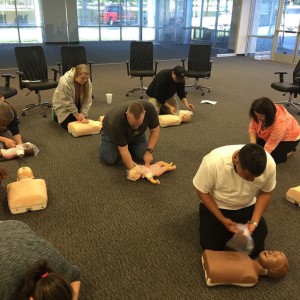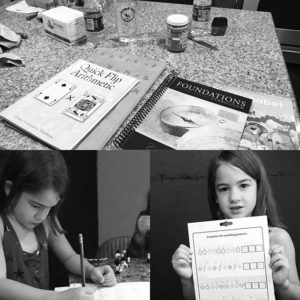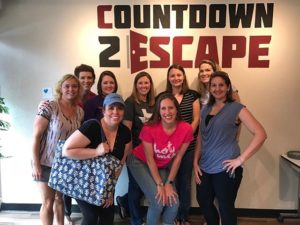Today I had the amazing privilege to give a Water Safety and CPR presentation at the Ann and Nate Levine Academy in Plano!
The participants came ready and willing to learn. They all did a wonderful job sharing their experiences and asking questions. It was asked that we share some of the main points for everyone’s future reference. I thought about just emailing the participants but then realized it would be good information for all our readers to remember!
Accidents are not planned and the best way to handle any situation is to be prepared ahead of time. Just having a plan in place will give you confidence to handle any situation you may face. We decided that Prevention Starts with US and it begins NOW!
I encourage you, as I did the ladies today, to take time and talk with your family and set your own Summer and Water Safety Rules TODAY! Talk about them with your children often, even as you go about your daily life and are not near the water.
Growing up as a fireman’s daughter we had very strict rules about being in and near water. My father had pulled too many children from backyard pools to take chances with his own children. My mother would always put our life jackets on us BEFORE we even were at the pool fence of our neighborhood pool. We had to ALWAYS wear a life jacket at the lake. If we were going to a new friend’s house we had to ask if they had a pool and then my parents would decide if we could go or not and it always depended on who was going to be watching us.
Here are some of the Water Safety Rules my family follows. Be sure to share your own with us! Learning together we can BE THE DIFFERENCE in the lives of those we love.
BEFORE entering the pool:
- Apply Sunscreen
- Put on a life jacket or other approved floatation aid (swimmies, puddle jumper, etc. I personally prefer the swim belts as it keeps our daughter’s hands free to learn proper swim technique)
Once INSIDE the pool area – but BEFORE in the pool:
- Check the water to be sure there isn’t anything unsafe in the pool.
- Locate the Safety Equipment (Life buoy (rings or tube) and Shepherd’s Hook) – teach your children where they are located and how to use them.
- Walk around the pool and talk about what the different numbers mean – depth of water; Higher numbers means deeper water.
- Locate the main entrance and exits. Are there any other points to get out.
- Notice if a Lifeguard is present. How many? We make it a game to count the lifeguards and know where they are stationed. We often will say hello so that the kids are not afraid to ask the lifeguards for help if they need it. Build the relationships. I demonstrate respect for the lifeguards so my children will also.
- See if you can find the AED Machine and Phone.
IN the POOL:
- Only swim with Adult Supervision – we define adult as a responsible person with a driver’s license. Asking older siblings (under 16) is NOT a good idea.
- Adults should always swim with at least one other adult – you could bump your head or end up with a leg cramp and need help.
- Practice with your children swimming to and holding on to the side of the pool.
- Practice with your children swimming to the steps/stairs or entrance to the pool. We do this a few times throughout our play time in the pool as it can be easy to get disoriented in the water. Teaching the kids to always be aware of the exits and sides will really help them if they get tired.
- Teach the children to FLOAT on their backs. Have them swim a bit and then turn to float on their back.
- Use ONLY approved floatation devices to help your child stay safe. Placing an unskilled swimming child in or on a toy and letting them cruise the pool unattended is very dangerous. Keep a hand on them at all times. POOL TOYS ARE NOT FLOATATION DEVICES.
- Talk about appropriate play in the pool. We do not rough house or play games that call out for “HELP”. Yelling “HELP” is only for when in danger.
- Keep the water clear of extra pool toys not in use. They are distracting and can block the view of lifeguards or water watcher.
- Assign Water Watchers to keep track of everyone in the pool. Give them a Water Watcher Lanyard (you can order them or make your own easily). Water Watcher is constantly surveying the area looking for any struggling swimmers. They should only work about a 15 min shift and will need to NOT be involved in conversations with others. They should strictly focus on the water.
When Leaving the Pool Area:
- Walk behind your children or holding their hands. Today it was shared, that while lifeguarding, a participant watched a family leave the pool. The parents leading the way, did not notice one of their children slipping into the pool. Within seconds the lifeguard was able to rescue the child but the parents did not even realize what had happened until the child was out of the water. Thankfully, this woman was watching and sprinted into action quickly and saved the child’s life.
These are just my suggestions and are not an exhaustive list. Be sure to talk with your family and make your own Water Safety Rules!!
Remember, it only takes a little drop of water for a child to drown. It doesn’t have to be the pool. Drownings occur in bucket of shallow water, bathtubs, pools, rivers, oceans, lakes, etc. Every SECOND counts. A person can drown in as few as 20 – 60 seconds.
Interested in learning more about Keeping your Family and Loved Ones Safe? Sign up for a CPR Class and we will tailor it to fit your learning needs! You can BE the DIFFERENCE in someone’s life just by taking a CPR course through North Texas CPR.
Be SAFE this Summer and All year Round!
Hugs,
Adrian



